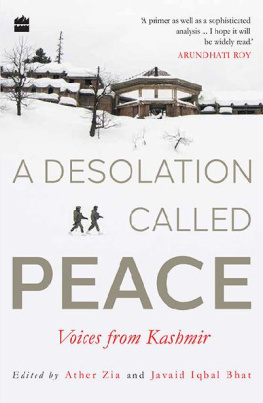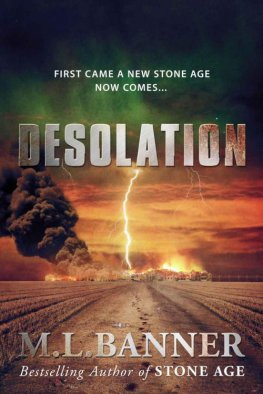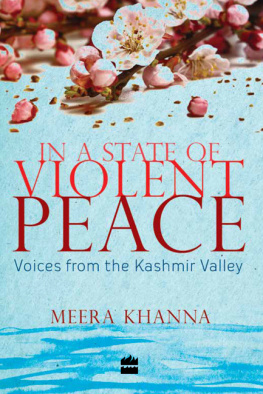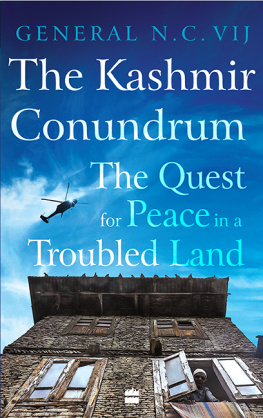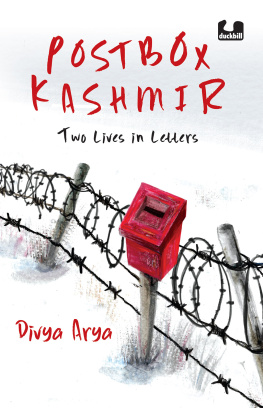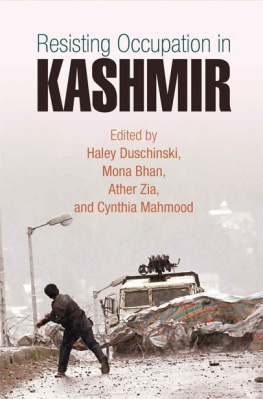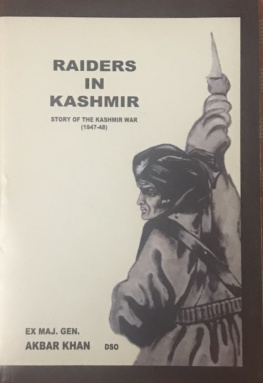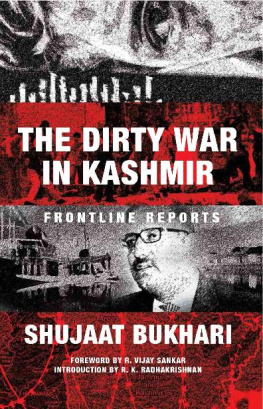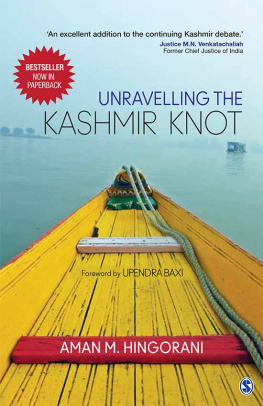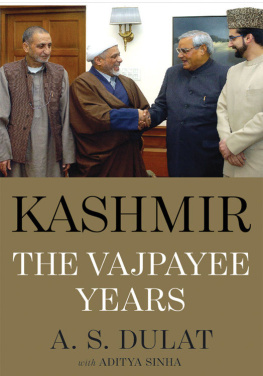Ather Zia - A Desolation Called Peace: Voices from Kashmir
Here you can read online Ather Zia - A Desolation Called Peace: Voices from Kashmir full text of the book (entire story) in english for free. Download pdf and epub, get meaning, cover and reviews about this ebook. year: 2019, publisher: HarperCollins Publishers India, genre: Politics. Description of the work, (preface) as well as reviews are available. Best literature library LitArk.com created for fans of good reading and offers a wide selection of genres:
Romance novel
Science fiction
Adventure
Detective
Science
History
Home and family
Prose
Art
Politics
Computer
Non-fiction
Religion
Business
Children
Humor
Choose a favorite category and find really read worthwhile books. Enjoy immersion in the world of imagination, feel the emotions of the characters or learn something new for yourself, make an fascinating discovery.
- Book:A Desolation Called Peace: Voices from Kashmir
- Author:
- Publisher:HarperCollins Publishers India
- Genre:
- Year:2019
- Rating:4 / 5
- Favourites:Add to favourites
- Your mark:
- 80
- 1
- 2
- 3
- 4
- 5
A Desolation Called Peace: Voices from Kashmir: summary, description and annotation
We offer to read an annotation, description, summary or preface (depends on what the author of the book "A Desolation Called Peace: Voices from Kashmir" wrote himself). If you haven't found the necessary information about the book — write in the comments, we will try to find it.
A Desolation Called Peace: Voices from Kashmir — read online for free the complete book (whole text) full work
Below is the text of the book, divided by pages. System saving the place of the last page read, allows you to conveniently read the book "A Desolation Called Peace: Voices from Kashmir" online for free, without having to search again every time where you left off. Put a bookmark, and you can go to the page where you finished reading at any time.
Font size:
Interval:
Bookmark:
A DESOLATION
CALLED PEACE
Voices from Kashmir
Edited by
ATHER ZIA AND JAVAID IQBAL BHAT

For Kashmir and its people
In remembrance of Gulam Ahmed Lone and Gulam Ahmed Bhat
[rest in peace and power]
Contents
Narrative: Khurram Parvez
Written by: Haziq Qadri
Narrative: Abdul Qadeer Dar
Written by: Nawaz Gul Qanungo
Ather Zia and Javaid Iqbal Bhat
T HE entirety of Kashmir, which includes what are currently the two parts of the Valley under the control of India and Pakistan, has been the abode of tragedy for more than five centuries. When the Western colonial power in South Asia was on the rise, Kashmir was being handed over from one tyrannical dynasty to the next. Finally, in 1846, the British colonizers sold the Kashmir Valley along with its sprawling provinces to the Dogra warlords for a sum of 750,000 Nanak Shahi rupees. Kashmir being a British protectorate, the Dogras were required to present annually the Crown with one horse, twelve shawl goats and three pairs of the finest Kashmiri shawls. This historic treaty included the sale of not only the land but also its people.
During the colonial period Kashmir was depicted in scenes full of holiday idyll, wilderness and romance. Photographs from a bygone era are replete with verdant valleys, majestic peaks capped with snow, white waters rushing down mountains, wild flowers and pashmina goats. An odd native or two may be seen lurking, but they are usually shown in service to royals, or the English sahibs.
The 100 years of Dogra rule were ruthless for the majority of the Muslim population. Interestingly, even though Kashmiris had been burdened by centuries of slavery, they had a resilient spirit and a long history of resistance. By the early nineteenth century, while India was fighting to oust the British, Kashmiris were fighting to overthrow the Dogra feudal rule.
One of the most iconic grass-roots agitations against Dogra rule occurred in 1931. At that time the Kashmiris rose against unjust laws, which were used to crack down on the population. The prosecution of one of the leaders named Abdul Qadeer led to mass demonstrations. On 13 July 1931, the maharajas police went on a rampage and ended up killing twenty-two Kashmiris in a dramatic manner. As the time for obligatory prayers approached, one Kashmiri protester rose to give the azan (call to prayer). When he stood up, the Dogra governor Raizada Triloki Chand ordered police to fire upon him. As the wounded man fell in a heap, another Kashmiri stood up to complete the azan and was shot down as well. This went on till twenty-two men were executed in public trying to finish the call to prayer as part of their protest. By 1944, much of the social, religious and economic discontent congealed into the famed Quit Kashmir movement, which demanded a sovereign democracy free from the maharajas rule.
After the end of British rule in 1947, when the dominions of Pakistan and India came into being, the Kashmir region was forced to choose between joining one of the two dominions. Under the Mountbatten plan, independence was not an option. The Partition had been on religious lines, according to which Kashmir as a Muslim-majority state would go with Pakistan. The monarch fled Kashmir, and a full-scale war between India and Pakistan ensued. In this anthology, Zahir U Dins essay does delve into some detail around the challenges to the authenticity of the accession.
Pandit Jawaharlal Nehru, Indias first prime minister, took the issue to the United Nations in January 1948. In its complaint to the United Nations, India reiterated its pledge of conditional commitment to a plebiscite or referendum under international auspices to settle the question of Kashmir. The United Nations brokered a ceasefire line, splitting the region between the two nations. The UN-brokered truce resulted in one-third of the territory becoming a semi-autonomous entity within Pakistan known as Azad Jammu and Kashmir (AJK). The remaining two-thirds, including the Valley of Kashmir, was placed under Indian control. In the following years, the United Nations formed the United Nations Commission for India and Pakistan (UNCIP). In 1949, UNCIP recommended handing over the region to a quasi-sovereign power of the plebiscite administrator. The UN crafted several plebiscite models, all of which failed due to the competing preconditions put forth by both India and Pakistan.
In 1951, India concertedly began a policy of legitimizing its government through holding elections. Pakistan protested, arguing that India was planning to finalize the accession. The United Nations Security Council (UNSC) warned India that the assembly might conflict with its recommendations still sub judice and deemed the course of action out of order. The UN dispatched several mediators to investigate the election malpractice and continued exploring options for demilitarization and a plebiscite. After 1954, cold war rivalries froze the Kashmir dispute. Subsequently, the United Nations deployed a military observer group in India and Pakistan (UNMOGIP), which continues to monitor the region through its forty-four installations. The plebiscite was never held.
The presence of UNMOGIP is a continuous reminder to Kashmiris that the issue is not solved yet and that the UN has promised to hold an internationally monitored plebiscite to decide the fate of Kashmir according to the wishes of its people. In this anthology we see the icon of UN appear as a reminder of the persistent nature of Kashmir as an international dispute awaiting resolution. The UN office in Srinagar has become the hub for demonstrations and submitting of memoranda demanding the right to self-determination. At one point a 400,000-strong crowd, marched to the UN office in Srinagar to hand over memoranda demanding plebiscite. Kashmiris continue to demand that sovereignty be added as an option to reflect their desire for nationhood, a struggle they insist is older than India or Pakistan. In Kashmir, the fraught era between 1947 and 1989 is characterized by undying political aspirations for azadi (independence), a section seeking alliance with Pakistan, aborted movements for liberation from India, and Indo-Pak wars.
Many Indian analysts and policymakers have often projected these seventy-odd years solely in terms of establishing Indias governing apparatus, with scant regard to the suppressed political desires of the Kashmiri people. For Indians and many foreigners, this era often appears synonymous with Kashmirs image as the playground of India, an idea that has been majorly peddled by Bollywood movies and reinforced by pro-India politicians active inside Kashmir. However, for Kashmiris, the fortification of the ideological and repressive state apparatuses implemented from New Delhi are a part of Indias strategy for tightening its hold on the territory. Even though many Kashmiris have consistently expressed a desire for an independent state, their demand has been reduced to a mere territorial dispute between India and Pakistan, and often completely ignored. Since 1947, political intrigue, arrests and electoral machinations had become the central motif of Indias relationship with Kashmiris, until 1989 the year when it came fully undone.

The core attempt of this anthology is to pry open a political wound, to explore the Kashmiri aspiration for azadi as an indigenous and historical demand. This anthology is based on accounts from Indian-administered Kashmir (henceforth referred to as the Kashmir Valley) and will explore the era between 1947 until 1989. Our attempt is to cull an ethnographic memory of what these years were like for the authors, all of whom are Kashmiris; exploring how their political consciousness took root and grew, and what its nature and purpose was.
Next pageFont size:
Interval:
Bookmark:
Similar books «A Desolation Called Peace: Voices from Kashmir»
Look at similar books to A Desolation Called Peace: Voices from Kashmir. We have selected literature similar in name and meaning in the hope of providing readers with more options to find new, interesting, not yet read works.
Discussion, reviews of the book A Desolation Called Peace: Voices from Kashmir and just readers' own opinions. Leave your comments, write what you think about the work, its meaning or the main characters. Specify what exactly you liked and what you didn't like, and why you think so.

